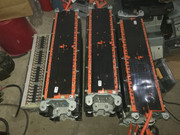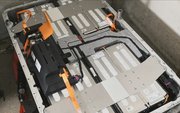Pomst said:
[
RC batteries are nothing like EV batteries.
RC batteries are High Discharge and High Charge which if used kills the cell quickly.
Storage of these types of cells is excellent if the cell is Ok since the internal resistance is very, very low.
What kills them is the amount of current they use, basically the C rating that is used for charging/discharging.
Sorry to be "that guy", but if you are using a 7S pack for a bike that means you will definitely be using more then 2C.
A normal 20C pack is about 4Ah which is very little. With 2C you would be pulling 8A, which at 7S is 25.9V nominal.
That means that if you were not using more then 2C then your bike would not be producing more then 207.2Watt (8A * 25.9V) of power at any time, which is just not possible.
If you want an experience of "went up the hills like a rocket" you need 500W or more, that would give you at least 6C or more depending on your definition of "rocket".
Take peak current and hill variations in to account and you are probably looking at peaks of 10C to 15C discharge (40A to 60A peak) which would kill a pack quickly.
I have about 9KWh of Prius+ cells (from crashed Taxis with 400 000+km on the clock mind you) in my garage.
All of which have an internal resistance of about 1mOhm (basically lower then I can measure).
All of them have been sitting for the past 2 years with No measurable degradation what so ever. Every single one of the 56 cells perform as new.
I also have about 2kWh of Prius+ cells fully charged (4.1V) for the past year with no measurable degradation.
Degradation of EV Lithium cells is very small over a 10 year period.
Anyone saying anything else has far too little experience with batteries.
As the icing on that statement I would like to point out that if this was not the case then Tesla would never give the warranty they do.
Here are some images of the batteries I am working on currently.
Many packs from Prius+ (or V if you like) and one large pack from a VW GTe.
WHAT A LOAD OF CROCK!
While it is admirable that you collect batteries, that can hardly be representative for the huge amount of people who are dissatisfied with their PHEV
battery degradation, otherwise we would not be having all these forum threads about the topic and guys like Andy on Youtube posting 100's of Videos.
Tesla can not be compared here as in general use they might be cycled 1-2 times a week , while the PHEV mostly daily and in some cases held every night at 4.1V cell voltage.
As for my bike it does have a 200W 24V motor that originally ran on NiCads. This 8.33A at the rated voltage.
The battery pack consisted of 3 x 3.3Ah 7s batteries = 9.9Ah.
When new and fully charged the voltage would stay above 28.5V on the hill in question. That is 9.89A, less than 1C of the pack.
Assuming I actually had a motor that was capable of 500W, 2C would be 564W and more than enough to deliver and a whole order of magnitude less than what it is rated for, unlike EV batteries.
However the motor has only 200W rated and would have been running at 282W up that hill and maintained the speed at 20km/h. Bike has a speed limiter at 23km/h, it is something legal.
After a year held at full charge (LiPos are charged up to 4.2V it would not go up faster than 9km/h, so relatively speaking it used to 'fly' up those hills like a 'rocket'.
Yes LiPos are not EV batteries we all know that.
They are nevertheless all Li-Ion batteries.
It is common knowledge that all Li-Ion batteries suffer degradation when stored at full charge.
There is a lot of science, research and empirical evidence over the last 25 years that supports the claim that Li-Ion batteries are best stored at 3.7V
There is also some evidence suggesting that keeping batteries stored at temperatures near 0˚C is beneficial.
This MIGHT also have something to do why Australian users of the car are complaining more about battery degradation than from countries with colder climates.






























